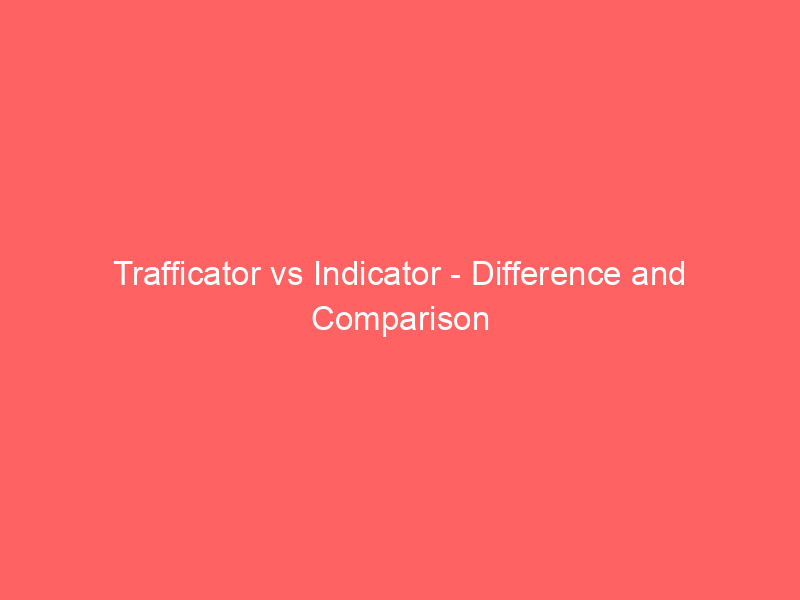Disclosure: This post contains affiliate links, which means we may earn a commission if you purchase through our links at no extra cost to you.
Key Takeaways
- Trafficator signals are mechanical devices, whereas indicators are electronic systems.
- Indicators provide more precise communication, with visual and audible alerts.
- Trafficator lights blink at a set pattern, while indicators may vary in display style.
- Designs of trafficators tend to be simpler, while indicators incorporate advanced technology.
- Understanding the differences helps drivers choose the correct signaling method for safety.
What is Trafficator?
Trafficator refers to a mechanical blinking device attached to a vehicle’s exterior, used for signaling turns or lane changes. Although incomplete. They are operated manually by the driver through a switch or lever.
Mechanical Operation
Trafficators are activated by pressing a button or moving a lever, causing the lights to flash intermittently. This mechanical setup is simple and does not require complex electronics.
Design and Appearance
They is designed with basic bulb or lamp setups, in orange or amber color, mounted on the vehicle’s sides. The design simplicity makes them easy to repair or replace,
Usage and Signal Pattern
Most trafficators blink in a regular, rhythmic pattern to indicate a turning intention. They are visible from a distance and are effective in alerting nearby drivers.
Limitations
Being mechanical, trafficators can sometimes malfunction or get stuck, leading to improper signaling. Their limited features mean less customization or additional alerts,
What is Indicator?
Indicator, also known as turn signals or blinkers, are electronic signaling devices integrated into the vehicle, designed to communicate driver intentions clearly. Although incomplete. They combine lights with circuitry for enhanced functionality.
Electronic Functionality
Indicators are operated via a switch, activating electronically controlled lights that flash at preset intervals. They include features like automatic shut-off or hazard modes.
Design and Features
Modern indicators feature sleek, integrated designs with LED lights, making them more visible and energy-efficient. They also include sound alerts for added safety.
Signal Customization
Indicators can vary in flashing patterns, brightness, and even color, providing more flexibility for different vehicle types or driver preferences. Some include sequential or adaptive flashing options.
Advanced Safety Integration
Many indicators are connected to vehicle systems that automatically activate or deactivate based on driving conditions. They can also synchronize with hazard lights or lane assist features.
Comparison Table
Below are a detailed comparison of trafficator and indicator on various aspects:
| Aspect | Trafficator | Indicator |
|---|---|---|
| Operation Type | Manual and mechanical | Electronic and automated |
| Power Source | Battery or vehicle power | Battery or vehicle power with circuitry |
| Design Complexity | Simpler, basic structure | More sophisticated, integrated design |
| Signal Style | Flashing bulbs, non-adjustable | Adjustable patterns, LED or incandescent |
| Customization | Limited options | Variety of flashing modes and colors |
| Maintenance | Requires manual checks, easy to repair | May need electronic diagnostics |
| Visibility | Depends on bulb brightness and placement | Enhanced with LED and electronic controls |
| Safety Features | Basic flashing | Includes automatic shut-off, alerts |
| Cost | Lower initial cost | Higher cost due to technology |
| Installation | Simple, straightforward | Requires electrical integration |
| Durability | Less vulnerable to electronic failure | More sensitive to electrical issues |
| Compatibility | Compatible with older models | Standard in newer vehicle models |
Key Differences
- Operation mechanism are clearly visible in trafficators being mechanical, while indicators operate electronically.
- Customization options revolve around pattern variation in indicators, unlike trafficators which are fixed in flashing style.
- Design sophistication is noticeable when comparing the simple bulbs of trafficators to the sleek LEDs of indicators.
- Integration with vehicle systems relates to indicators being linked with other safety features, whereas trafficators are standalone devices.
FAQs
Can trafficators be upgraded to electronic indicators?
Yes, some vehicle owners replace mechanical trafficators with electronic indicator systems for better visibility and features, but it requires electrical modifications and compatibility checks.
Are LED indicators more energy-efficient than trafficator bulbs?
Definitely, LED indicators consume less power, last longer, and offer brighter illumination, making them more effective for modern vehicle signaling.
How do indicators improve safety during night driving?
Indicators with brighter LED lights and audible alerts make driver intentions clearer in low-light conditions, reducing chances of miscommunication.
Can malfunctioning trafficators cause safety issues?
Yes, if trafficators fail or get stuck, other drivers may not understand your intentions, increasing the risk of accidents or confusion on the road.


 Eleanor Hayes
Eleanor Hayes